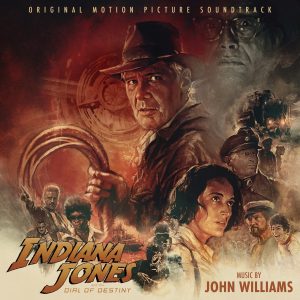
I have a few memorable moments from my youth watching Indiana Jones movies. I found the dinner scene from Temple of Doom quite disgusting as a kid, and the same goes for ripping out the heart from a living person in the same movie, but overall I was able to watch most of the film without looking away. I saw The Last Crusade in the movie theater back then, which also has some scary scenes, but because I was a bit older, I was able to enjoy that movie immensely. If you had told me back then that I would see another feature with Harrison Ford portraying Indiana Jones in 2023, I wouldn’t have believed it. Yet here we are with Indiana Jones and the Dial of Destiny, the fifth movie in the series, again with a score composed by the great John Williams.
I was quite curious what Williams would do with the music for a new Indiana Jones movie since each score for the first three movies is considered to be a classic, and I have heard “Raiders March” and “Marion’s Theme” during many film music concerts. While all of the movies use the iconic “Raiders March,” Williams always creates new, stunning themes for each new film featuring the famous adventurer. The most prominent theme for Dial of the Destiny is the theme for the newly introduced adventurous woman Helena, and her music can be heard in full detail in “Helena’s Theme.” As with most themes Williams has written for strong female leads, this theme also consists of gorgeous melodic lines. In the final track on the album you can hear another version of the theme, performed by violinist Anne-Sophie Mutter, with whom Williams has been collaborating for the last few years.
I need to mention two additional new themes, and both can be heard, together with Helena’s theme, in the first track, “Prologue to Indiana Jones and the Dial of Destiny,” which, contrary to what the title suggests, is played during the end credits. The first theme is for the Nazis and their leader Voller. It is played right after Helena’s theme in that track, and it consists mainly of the brass section of the orchestra playing ominous-sounding lines. The second additional theme is the one for the Dial of Destiny itself. Its mysterious-sounding melody is performed on a dulcimer-like instrument to emphasize its potential, age, as well as the region it comes from.
Williams is a master at integrating themes into his film music, and for Dial of Destiny, this is no different. In addition to the new themes, you can hear “Raiders March” occasionally, but it is scarce. It is only used when the theme really matters, like, in “Germany, 1944,” but also, of course, as a conclusion to the story in “New York, 1969.” In addition to Helena’s theme and the “Raiders March,” that last track contains another iconic piece, “Marion’s Theme” from Raiders of the Lost Ark, which fits the scene perfectly.
Not all the music from the movie can be found on the soundtrack album, making it less easy to explore all the themes, leitmotifs and nods to other Indiana Jones movies John Williams has put in place on this wonderful, purely orchestral score. Many soundtrack fans are a bit disappointed by not having all the music available, but I do not mind that much, as I like a more compact and curated listening experience.
I do not have to tell you that John Williams is the best film music composer alive. Even at 91, his output outclasses the majority of music written for any medium. His skill in using a traditional orchestra to support and elevate a scene perfectly is a brilliant showcase of how melodies and the performance by the musicians can be used to bring the right kind of emotional feelings to the images on screen, as he has done again for Indiana Jones and the Dial of Destiny. Williams does not need different instruments and sounds, such as percussion, to keep an action sequence going and stay original or innovative, making the soundtrack a fantastic listening experience from start to finish. That is why, unsurprisingly, Indiana Jones and the Dial of Destiny is a masterpiece. It is one of the highlights of this final phase of John Williams’ career.
Listen or buy
- Buy this soundtrack digitally from Amazon.com or Apple Music
- Listen to this soundtrack on Spotify
Tracklist
The highlights are in bold.
- Prologue to Indiana Jones and the Dial of Destiny (6:00)
- Helena’s Theme (3:30)
- Germany, 1944 (4:42)
- To Morocco (3:21)
- Voller Returns (3:06)
- Auction at Hotel L’Atlantique (2:58)
- Tuk Tuk in Tangiers (3:35)
- To Athens (2:17)
- Perils of the Deep (2:31)
- Water Ballet (4:53)
- Polybius Cipher (2:39)
- The Grafikos (4:39)
- Archimedes’ Tomb (3:01)
- The Airport (4:46)
- Battle of Syracuse (2:50)
- Centuries Join Hands (3:02)
- New York, 1969 (4:17)
- Helena’s Theme (For Violin and Orchestra) (4:59)
Total length: 1 hour and 7 minutes
Walt Disney Records (2023)




